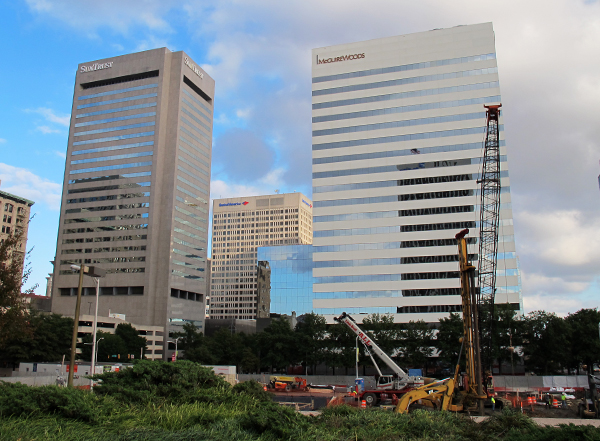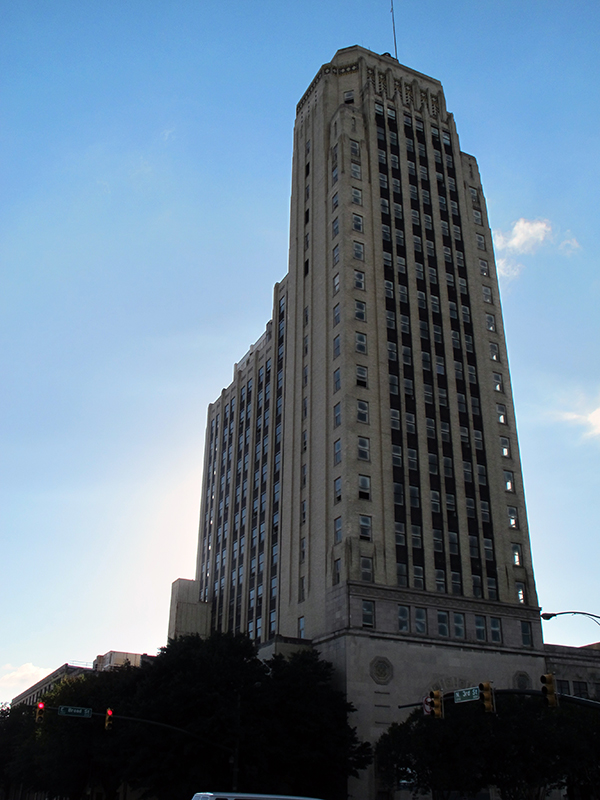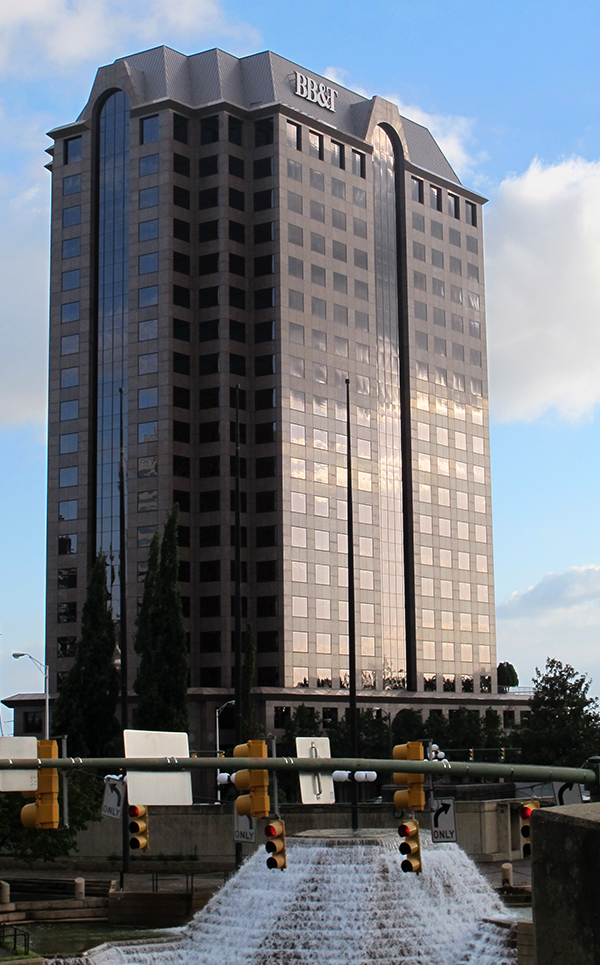
One James Center, right, overlooks the Gateway Plaza construction site. (Photos by Burl Rolett)
As Richmond’s newest tower rises, a reshuffling of downtown office space might be set into motion.
The planned 18-story Gateway Plaza building will make a noticeable addition to the riverfront skyline. And when the shiny new tower welcomes its lead tenant in 2015, it will leave a McGuireWoods-size hole in another downtown tower.
The law firm will vacate 250,000 square feet at One James Center, considered upper-tier, “Class A” office space. Although filling that block of space won’t be easy, local commercial real estate brokers say the vacancy will be appealing to Class B tenants looking to move up.
The desire to upgrade might start a trickle-up effect that can spell trouble for the buildings at the bottom, making it harder to fill space and driving down lease rates on older and lower-tiered properties unless pricey renovations are made.
It’s the circle of life for downtown office buildings.

The CFB Tower at 219 E. Broad St. is listed as Class C.
“Historically, when we’ve seen that the Class B users move up to Class A, the Class C users move up to Class B, and we’ve seen Class C buildings become functionally obsolete,” said CBRE broker Will Bradley. “The question is what will happen to the older Class C buildings in the market.”
That answer will depend on the success of filling the hole at One James Center. The building’s 420,000 square feet are part of an 11 million-square-foot downtown office market, about 13.5 percent of which was vacant according to a third quarter market report from CBRE | Richmond.
The 20-story tower, built in 1984, sits across Ninth Street from the rising Gateway Plaza.
“That location is still the center of the universe for Class A users looking at downtown,” said Colliers International broker Steve Gentil of One James Center.
Space in the building goes for $26.50 per square foot, said Evan Magrill, a Cushman & Wakefield | Thalhimer broker in charge of leasing at the property. That’s about $6 higher than the average asking rate in Richmond’s central business district, which last quarter topped $20 for the first time since 2007, according a CBRE | Richmond market report.
That’s also higher than an average of $23.23 per square foot among its Class A downtown office peers, according to a Colliers International second-quarter market report.
Magrill would not give an estimate of what tenants might pay for space in the James Center two years from now, but he said the price is likely to decline and will depend on a number of factors.
“It depends how big a tenant is and what they need done to the space,” he said. “Can they utilize it in existing form with just cosmetic renovations, or does it need more than that?”
Several brokers said it is highly unlikely a single tenant will fill the void at One James Center. Instead, it will likely be chopped up and rented to several smaller tenants.
Austin Newman, a broker with Cushman & Wakefield | Thalhimer, is working with a similar situation at Deep Run III in Henrico County, a 380,000-square-foot office building left dark when tenant Circuit City went under in 2009.
“It’s safe to say that you can plan on it not being one tenant,” Newman said of filling large spaces. “You try to minimize how you break it up.”
The James Center, however, has a much smaller footprint than the sprawling suburban Deep Run III building. Some floors at the James Center are as small as 17,000 square feet, on average about 8,000 square feet smaller than other buildings in the downtown market.

Riverfront Plaza is Class A.
“The good news is that it is a smaller floor and they could go floor by floor – the bad news is if you’re [looking for] 100,000 square feet you have to take five floors,” Newman said.
Other examples of Class A office buildings downtown include Riverfront Plaza and SunTrust Center. Downtown Class B properties include the Mutual Building at 909 E. Main St. and the Imperial Building at 422 E. Franklin St. The CFB Tower at 219 E. Broad St. is listed as Class C and most recently had an asking rate of $10 per square foot.
Recently buildings that are no longer competitive in the office market have found new life through adaptive reuse projects. The former First National Bank building on Main Street had a $30 million conversion to 154 apartments last year. A similar transformation is underway at the 12-story 700 Centre building near the State Capital and the Exchange Place building at 1313 E. Main St.
Still, there are two years to go and 307,000 square feet left to rise before Gateway Plaza’s effects on downtown become clear.
“It’s been a long time since a new building has been delivered in Richmond, so it’s hard to predict the future,” Magrill said. “But with the economy rebounding, if we see some employment growth in the area, we shouldn’t have any problem leasing the space when it becomes available.
“It’ll take some time, but it’ll get leased.”

One James Center, right, overlooks the Gateway Plaza construction site. (Photos by Burl Rolett)
As Richmond’s newest tower rises, a reshuffling of downtown office space might be set into motion.
The planned 18-story Gateway Plaza building will make a noticeable addition to the riverfront skyline. And when the shiny new tower welcomes its lead tenant in 2015, it will leave a McGuireWoods-size hole in another downtown tower.
The law firm will vacate 250,000 square feet at One James Center, considered upper-tier, “Class A” office space. Although filling that block of space won’t be easy, local commercial real estate brokers say the vacancy will be appealing to Class B tenants looking to move up.
The desire to upgrade might start a trickle-up effect that can spell trouble for the buildings at the bottom, making it harder to fill space and driving down lease rates on older and lower-tiered properties unless pricey renovations are made.
It’s the circle of life for downtown office buildings.

The CFB Tower at 219 E. Broad St. is listed as Class C.
“Historically, when we’ve seen that the Class B users move up to Class A, the Class C users move up to Class B, and we’ve seen Class C buildings become functionally obsolete,” said CBRE broker Will Bradley. “The question is what will happen to the older Class C buildings in the market.”
That answer will depend on the success of filling the hole at One James Center. The building’s 420,000 square feet are part of an 11 million-square-foot downtown office market, about 13.5 percent of which was vacant according to a third quarter market report from CBRE | Richmond.
The 20-story tower, built in 1984, sits across Ninth Street from the rising Gateway Plaza.
“That location is still the center of the universe for Class A users looking at downtown,” said Colliers International broker Steve Gentil of One James Center.
Space in the building goes for $26.50 per square foot, said Evan Magrill, a Cushman & Wakefield | Thalhimer broker in charge of leasing at the property. That’s about $6 higher than the average asking rate in Richmond’s central business district, which last quarter topped $20 for the first time since 2007, according a CBRE | Richmond market report.
That’s also higher than an average of $23.23 per square foot among its Class A downtown office peers, according to a Colliers International second-quarter market report.
Magrill would not give an estimate of what tenants might pay for space in the James Center two years from now, but he said the price is likely to decline and will depend on a number of factors.
“It depends how big a tenant is and what they need done to the space,” he said. “Can they utilize it in existing form with just cosmetic renovations, or does it need more than that?”
Several brokers said it is highly unlikely a single tenant will fill the void at One James Center. Instead, it will likely be chopped up and rented to several smaller tenants.
Austin Newman, a broker with Cushman & Wakefield | Thalhimer, is working with a similar situation at Deep Run III in Henrico County, a 380,000-square-foot office building left dark when tenant Circuit City went under in 2009.
“It’s safe to say that you can plan on it not being one tenant,” Newman said of filling large spaces. “You try to minimize how you break it up.”
The James Center, however, has a much smaller footprint than the sprawling suburban Deep Run III building. Some floors at the James Center are as small as 17,000 square feet, on average about 8,000 square feet smaller than other buildings in the downtown market.

Riverfront Plaza is Class A.
“The good news is that it is a smaller floor and they could go floor by floor – the bad news is if you’re [looking for] 100,000 square feet you have to take five floors,” Newman said.
Other examples of Class A office buildings downtown include Riverfront Plaza and SunTrust Center. Downtown Class B properties include the Mutual Building at 909 E. Main St. and the Imperial Building at 422 E. Franklin St. The CFB Tower at 219 E. Broad St. is listed as Class C and most recently had an asking rate of $10 per square foot.
Recently buildings that are no longer competitive in the office market have found new life through adaptive reuse projects. The former First National Bank building on Main Street had a $30 million conversion to 154 apartments last year. A similar transformation is underway at the 12-story 700 Centre building near the State Capital and the Exchange Place building at 1313 E. Main St.
Still, there are two years to go and 307,000 square feet left to rise before Gateway Plaza’s effects on downtown become clear.
“It’s been a long time since a new building has been delivered in Richmond, so it’s hard to predict the future,” Magrill said. “But with the economy rebounding, if we see some employment growth in the area, we shouldn’t have any problem leasing the space when it becomes available.
“It’ll take some time, but it’ll get leased.”



So now the old Central National Bank building (you called it CFB Tower) is back to being listed as class C office space. It will not be apartments as you all and everyone reported
http://www.richmondbizsense.com/2013/01/22/developer-banks-on-east-broad-empire/
This building as NO use now as it has not been used outside of its lobby branch for almost 15 years. All I saw recently was they secured some of the facade. Any updates RBS?
When I saw the title of this I thought that maybe this building was going to grow a few more floors but unfortunately that’s not what this article is about. Sometimes I think Richmond would rather have two 15 story “buildings” than one 30 story tower.